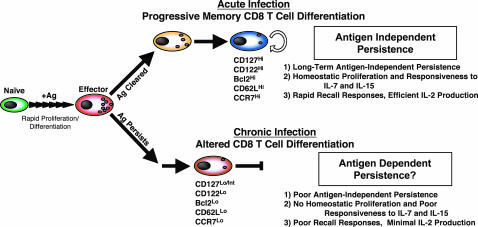Fig. 5.
Model of CD8 T cell differentiation during acute versus chronic infections. During the first week of infection naïve antigen-specific CD8 T cells undergo antigen-driven proliferation and differentiation into effector CD8 T cells. If antigen is cleared (i.e., acute infection) 5–10% of CD127Hi effector CD8 T cells (14) survive and undergo further antigen-independent differentiation, resulting in the generation of memory CD8 T cells that have acquired three defining memory T cell properties: (i) long-term antigen-independent persistence, (ii) homeostatic proliferation in response to IL-7 and IL-15, and (iii) rapid recall responses including vigorous antigen-driven proliferation, secretion of cytokines (IFN-γ, tumor necrosis factor α, and IL-2), and acquisition of cytotoxicity (2, 12–14) (Upper). In contrast, if antigen persists past the effector stage and a chronic infection ensues (Lower) the antigen-independent phase of memory CD8 T cell differentiation does not occur and the resulting CD8 T cells do not optimally develop the three main memory T cell properties.

